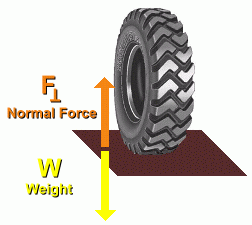Physics
Newton's First Law states:
If the net force on an object is equal to zero, the objects will remain at rest if it was at rest. If it was moving, it will remain in motion in a straight line with the same constant velocity.
Newton's Second Law states:
If a net external force, (F), acts on an object with mass m, the force will cause an acceleration, a, in the same direction as the force:
F=ma
Newton's Third Law states:
The forces that two interaction objects exert on each other are always exactly equal in magnitude and opposite in direction:
F1-2=-F2-1
Also The Force of friction is equal to:
(friction coefficient)x(Normal Force)
Normal force is found by:

Image link
So if the cars wheel hits a bump, that creates a force upward toward the car. This force can be calculated with the mass of the car multiplied by the acceleration given by the bump If there was no shock to catch the force and no spring to let go, the force will be transferred to the car seat and tell the driver that a bump was hit.
The shock's job is to keep the wheel grounded at all times. The bump is hit therefore acceleration is directed upward, the shock receives this acceleration and push the wheel back to the ground.
The spring regulates how fast to push the wheel back to ground. The spring has a certain spring constant associated with it which tells us the characteristics of the spring. The placement of the spring is also important.
If the car drops into a dip then the spring forces the wheel to be grounded and shock regulates that action.
If the net force on an object is equal to zero, the objects will remain at rest if it was at rest. If it was moving, it will remain in motion in a straight line with the same constant velocity.
Newton's Second Law states:
If a net external force, (F), acts on an object with mass m, the force will cause an acceleration, a, in the same direction as the force:
F=ma
Newton's Third Law states:
The forces that two interaction objects exert on each other are always exactly equal in magnitude and opposite in direction:
F1-2=-F2-1
Also The Force of friction is equal to:
(friction coefficient)x(Normal Force)
Normal force is found by:

Image link
So if the cars wheel hits a bump, that creates a force upward toward the car. This force can be calculated with the mass of the car multiplied by the acceleration given by the bump If there was no shock to catch the force and no spring to let go, the force will be transferred to the car seat and tell the driver that a bump was hit.
The shock's job is to keep the wheel grounded at all times. The bump is hit therefore acceleration is directed upward, the shock receives this acceleration and push the wheel back to the ground.
The spring regulates how fast to push the wheel back to ground. The spring has a certain spring constant associated with it which tells us the characteristics of the spring. The placement of the spring is also important.
If the car drops into a dip then the spring forces the wheel to be grounded and shock regulates that action.